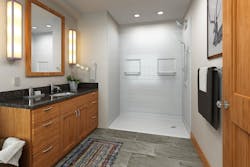Universal design principles: Part 1
It is easier than ever today to design commercial projects with accessible spaces that look as good as they perform. Good looks and accessibility can play together to create spaces that are as handsome as they are functional.
While accessibility rules on both state and federal levels have stringent dimensional requirements governing maneuverability and reach in commercial multifamily projects, those rules don’t have to be a hindrance in creating beautiful bathrooms.
First, you do need to know which standards apply to your project. Title II and III of the ADA apply to public facilities, while any type of multifamily housing (apartment buildings, student housing, senior living accommodation, hotels, etc.) is covered by the design requirements of the federal Fair Housing Act. The granddaddy of standards is ANSI A117.1, on which all other regulations lean.
Individual states may have their own standards, as well as code requirements for accessibility specified in the International Building Code (IBC) in whatever version of the code the particular state has adopted. You should identify which standards and codes apply to your project.
Universal design (UD) is a term you’re probably hearing more often. UD is not just disability-focused, but targeted to the needs of all people throughout the stages of their lives as their needs and abilities change. There are not codes specifically addressing UD. However, it is good to consider all of the potential users of your project to help ensure safety and comfort.
Many accommodations, whether mandated by government regulation or not, don’t have to look institutional. In many cases, they are not even visible. For instance, using porcelain rather than ceramic tiles on bathroom floors reduces slipping hazards, but a user would be hard-pressed to see the difference.
The CDC targets the bathroom as the most dangerous room in the house. Every year, about 235,000 people over the age of 15 come to the emergency room with injuries they’ve sustained in the bathroom, and 14 percent of those injuries result in hospitalization. Injuries increase with age, and for all ages the most accident-prone activities were bathing, showering, and getting out of the tub or shower. Architects can use principles of UD to reduce these hazards.
In the next blogpost in this series, we’ll take a look at how UD principles can play out in the bathroom.

